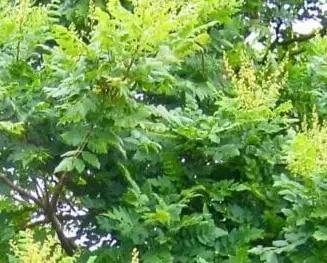Golden rain trees are native to China and Korea and mostly range in size from small to medium-sized. They are often irregular to spherical, with many trunks. The soft, green, big, multi-lobed, bipinnate leaves feature irregular, roughly oval, coarsely toothed, or lobed leaflets. When they first emerge in the spring, the leaves exhibit a medium to light green color, with pink or bronze undertones. They are emerald green in the summer and golden in the fall.
Blooms mostly begin to emerge at the very tips of the branches in the late summer or early fall. The seedpods that come after the flowers are also beautiful. They are papery and greenish pink to red but turn tan and brown as they age. This is a messy tree, as it produces a lot of flowers, fruit, and seed pods and then sheds them all over a long period.
Golden rain tree Pros and Cons
Attributes of this tree include:
- Produces little, yellow flowers approximately half an inch in diameter that are carried upright in clusters on a 12–18-inch-long stalk. Yellow color is uncommon among flowering trees.
- Three years after planting, it often begins to bloom from early June through July.
- Characterized by complex leaves that are dark green in color and range in length from 6 to 15 inches and are composed of 7 to 15 coarsely serrated leaflets and measure between 1 and 4 inches. They become pale yellow in the fall.
- Produces fruit resembling little lanterns with three sides, ranging in color from pale yellow to brown, and carrying black seeds.
- It makes a great street tree and is mostly planted near power lines and paved areas.
- It is resistant to pests and illnesses.
- Able to deal with the demands of city life, including heat and smog.
Extremely cold regions are not suitable for the golden rain tree. Frost damage is a possibility, especially on branch tips. Additionally, the timber is fragile and susceptible to storm damage. The twigs on a tree can die in the winter if the weather gets severely cold. The tree's relatively small root system does not provide sufficient anchorage in windy places, leading to blow overs.

Golden rain tree Growth Rate
Koelreuteria paniculata, often known as the golden rain tree, exhibits a spread of 30 to 40 feet with a large vase or globe form. Although sparingly branched, rain trees feature a wonderfully balanced and lovely density. Due to their open growth style, golden rain trees survive dryness and don't produce much shade. It makes an excellent street or parking lot tree, especially in areas with limited overhead or soil space. This golden rain tree grows at a moderate to rapid rate, with annual height gains ranging from 13 to 24 inches.
It belongs to the soapberry family, and its common name is "golden rain tree." The tree is covered in thousands of small flowers, each with four golden petals and a cinnamon-colored core. When the panicles mature, they produce three-sectioned, two-inch-long seed pods.
Golden rain tree Care
The optimal conditions for the tree's rapid development include full light and soils that are rich, deep, and well-drained. However, golden rain trees are also grown successfully in conditions of partial shade. Even different types of soil, such as clay, sand, loam, alkaline, and acidic, support their growth. They flourish in both wet and well-drained soil.
The management of this tree requires the following elements:
- Choose a sunny area in USDA hardiness zones 5 to 9 for the golden rain tree. The tree is adapted to soils that drain effectively.
- Throughout the growing season, make sure to give the tree regular watering with the garden hose. Once established, the tree is both drought- and flooding-resistant.
- During the winter, when the tree is dormant, use pruning shears to remove any branches that are crossing one another. Dead, damaged, or diseased branches are pruned at any time of year.
- Insects called scales develop lumpy, hard, or soft colonies; periodically inspect branches for these colonies. To smother unhatched eggs, spray the tree with horticultural oils like neem oil regularly in the spring.
- If leaves, blossoms, and seed pods pile and create a mess on walkways or drives, sweep them with a broom.
Golden rain tree Problems
Warm climates allow this tree to flourish. Verticillium wilt, a typical fungus that affects trees, is capable of causing damage to golden rain trees. It attacks leaves, causing them to wilt and eventually die. Complete tree death often occurs if the infection is severe. The tree's vitality and resistance to the fungus are increased with the help of fertilization.
Golden rain trees are susceptible to infestations of scale insects. These are small sucking insects housed in scab-like protrusions on the bark. They do not destroy the golden rain tree, but they make it less healthy. Oil sprays used in gardening are effective against scale. Bugs known as boxelder bugs feed very little on the tree, but their excrement leaves black stains on the bark of the tree.







0 Comments
For comments please reply here.......